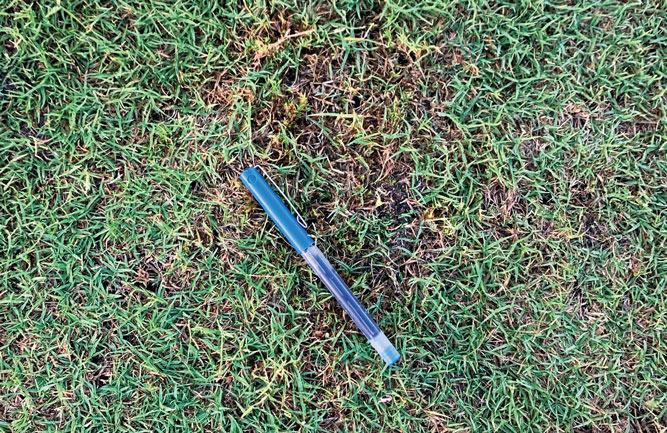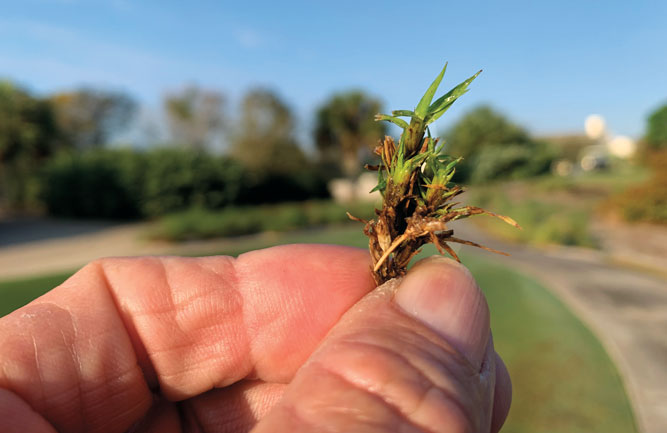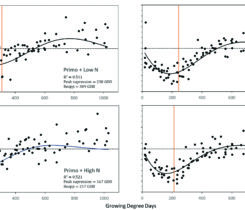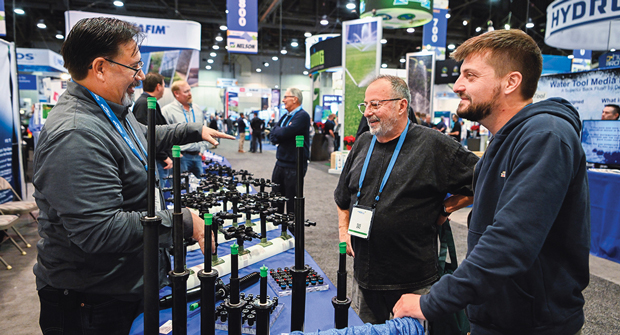Turf Pest of the Month: How one super is blazing a trail with bermudagrass mite management
As you’re scouting your course, you notice an area of general decline. The turf is yellow and weak. You look at it and think it’s stress and move on.
But Craig Weyandt, superintendent at The Moorings at Hawks Nest in Vero Beach, Fla., says superintendents, especially in the Southeast, shouldn’t be so quick to dismiss the warning signs of something more devastating — bermudagrass mites.
As the name indicates, these microscopic pests — also known as bermudagrass stunt mites — suck plant sap from bermudagrass varieties. The damage stunts the growth of the stems, causing the leaf sheaths to swell and cause a witch’s broom effect.
“It’ll start off as an area of general decline,” he says. “(The turf) is weak, kind of yellow. You’ve really got to look down at the leaf blades to notice the mutation.”
He says symptoms tend to show when daytime temperatures range between 65 to 80 degrees F.

Declining turf is a sign of stress, but it’s also a sign of bermudagrass mites. A telltale sign of bermudagrass mite damage is the stunted growth of turfgrass. (Photo: Craig Weyandt)
Blowing up
Weyandt surveyed a patch of weak and thin turf in the spring of 2013.
“When I went down and looked at it, I could see this mutated witch’s broom appearance to the grass,” he says. “I told my assistant, ‘These are stump mites,’ … and he is like, ‘No way.’”
Weyandt’s assistant superintendent hooked up a coin microscope to his computer to look at some samples. Sure enough, the assistant and Weyandt saw little round eggs in the turf.
Weyandt says he tried to manage the spread of bermudagrass stunt mites by mowing infected areas last and disinfecting equipment. The challenge to controlling the mites is the pest’s short life cycle and how easily it spreads.
“These mites can be spread by equipment, they can be spread by foot traffic, they can be spread by golf cart traffic,” he says.
Weyandt estimates bermudagrass mite eggs can go from an egg in a leaf sheath to adult in 5 to 10 days.
“Even if you kill an adult, you may not have killed an egg. Then, a week or two later, you’re going to have a whole ’nother hatch,” he says.
Weyandt says he’s watched bermudagrass mites rip through the Southeast at blazing speeds.
“I can find them on every hole of the two golf courses that the Moorings Club owns. I can go over to friends’ golf courses that don’t think they have them and find them,” he says. “Conditions have gotten worse, and we’ve watched it progress throughout the Southeast.”

(Photo: Craig Weyandt)
Control methods
Weyandt says control methods are a work in progress. Scalping the turf, removing the leaf blade clippings and disposing of the clippings is one option he learned about in turf school.
“Ideally, you’re collecting the insect in all stages of life and removing it from the host,” he says. “That’s really not realistic. If you’re talking about something that you’ve got on 40 acres, what would I do with 40 acres of grass clippings?”
Fraise mowing is another popular cultural control, he says. While some products have a label for mites, Weyandt says there’s a lack of information about best application times and rates and whether or not to use a wetting agent.
“I’ve had manufacturers say that they seem to be getting the best control in the fall, but I don’t have visible stunt mites in the fall, so how do I know where to treat it,” he asks. “Nobody wants to blanket applications of insecticides and have it wasted. We’re blazing a trail as we go along.”
To assist supers in diagnosing and treating damaged turf, the University of Florida created the bermudagrass mite discussion forum on Facebook.
Weyandt says he’s seen promise with a spirotetramat, an insecticide, which seems to help with turf recovery.












